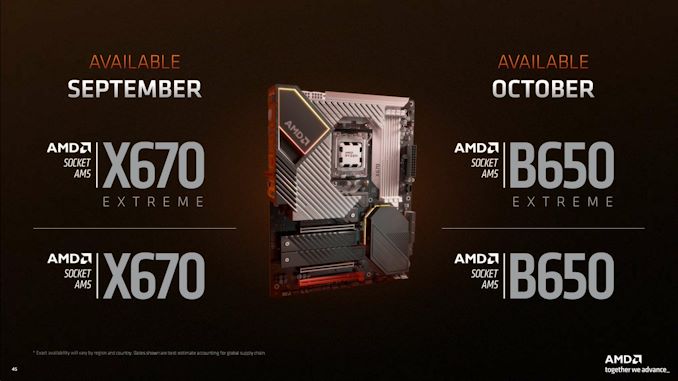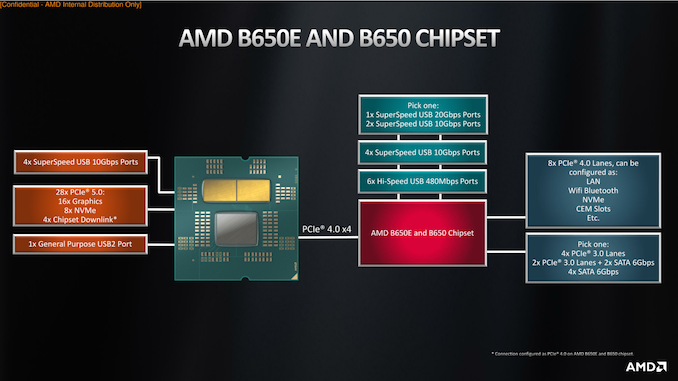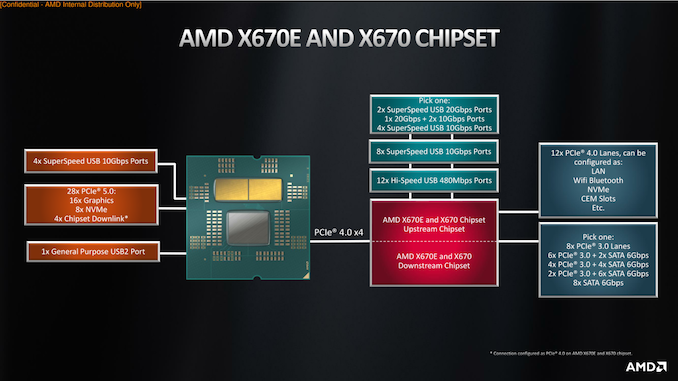AMD Zen 4 Ryzen 9 7950X and Ryzen 5 7600X Review: Retaking The High-End
by Ryan Smith & Gavin Bonshor on September 26, 2022 9:00 AM ESTAM5 Chipsets: X670 and B650, Built by ASMedia
Finally, let’s talk about the chipsets that are going to be driving the new AM5 platform. Kicking things off, we have the B650 and X670 chipsets, as well as their Extreme variations. Since AMD is starting the rollout of their new platform with their high-end CPUs, they are matching this with the rollout of their high-end chipsets.
For this week’s launch, the initial boards available are all from the X670 family. B650 boards will, in turn, be coming next month. We’ll break down the difference between the two families below, but at a high level, X670 offers more I/O options than B650. And while not strictly a feature of the chipset, the market segmentation is such that the bulk of high-end AM5 boards – those boards with a massive amount of VRMs and other overclocker/tweaker-friendly features – will be X670 boards.
That said, for simplicity’s sake we’re going to start with the B650 chipset, and build up from there.
| AMD AM5 Chipset Comparison | ||||
| Feature | X670E | X670 | B650E | B650 |
| CPU PCIe (PCIe) | 5.0 (Essentially Mandatory) | 4.0 (5.0 Optional) |
5.0 (Essentially Mandatory) | 4.0 (5.0 Optional) |
| CPU PCIe (M.2 Slots) | At Least 1 PCIe 5.0 Slot | |||
| Total CPU PCIe Lanes | 24 | |||
| Max Chipset PCIe Lanes | 12x 4.0 + 8x 3.0 | 8x 4.0 + 4x 3.0 | ||
| SuperSpeed 10Gbps USB Ports | 4 CPU + 12 Chipset or 4 CPU + 10 Chipset + 1 Chipset 20Gbps or 4 CPU + 8 Chipset + 2 Chipset 20Gbps |
4 CPU + 6 Chipset |
||
| DDR5 Support | Quad Channel (128-bit bus) Speeds TBD |
|||
| Wi-Fi 6E | Yes | |||
| CPU Overclocking Support | Y | Y | Y | Y |
| Memory Overclocking Support | Y | Y | Y | Y |
| Available | September 2022 | October 2022 | ||
B650, AMD’s mainstream AM5 chipset, can best be thought of as a PCIe 4.0 switch with a bunch of additional I/O baked in. And as is typical for chipsets these days, several of the I/O lanes coming from the chipset are flexible lanes that can be reallocated between various protocols. Meanwhile, uplink to the CPU is a PCIe 4.0 x4 connection.
For PCIe connectivity, B650 offers 8 PCIe 4.0 lanes, which can either have PCIe slots or further integrated peripherals (LAN, Wi-Fi, etc) hung off of them. This and the uplink speed are both notable improvements over the B550 chipset, which was PCIe 3.0 throughout, despite Ryzen 3000/5000 offering PCIe 4.0 connectivity. So B650 has a lot more bandwidth coming into it, and available to distribute to peripherals.
There are also a quartet of PCIe 3.0 lanes which are shared with the SATA ports, allowing for either 4 PCIe lanes, 2 lanes + 2 SATA, or 4 SATA ports. Notably, the dedicated SATA ports found on the 500 series chipsets are gone, so motherboards will always have to sacrifice PCIe lanes to enable SATA ports. For the B650 this amounts to a net loss of 2 SATA ports, as the most ports it can drive without a discrete storage controller is 4.
Meanwhile on the USB front, motherboard vendors get more Superspeed USB ports than before. The chipset offers a fixed 4 10Gbps Superspeed ports, and then an additional output can be configured as either a single 20Gbps (2x2) port, or two 10Gbps ports. Finally, the chipset can drive a further 6 USB 2 ports, mostly for on-board peripheral use. There are no USB root ports limited to 5Gbps here, so all USB 3.x ports, whether coming from the CPU or the chipset, are capable of 10Gbps operation.
AMD has once again outsourced chipset development for this generation to ASMedia, who also designed the B550 chipset. AMD has not disclosed a TDP for the chipset, but like B550 before it, it is designed to run with passive cooling.
Outside of the technical capabilities of the B650 chipset itself, AMD is also imposing some feature requirements on motherboard makers as part of the overall AM5 platform, and this is where the Extreme designation comes in. All B650 (and X670) motherboards must support at least 1 PCIe 5.0 x4 connection for storage; Raphael has enough lanes to drive two storage devices at those speeds, but it will be up to motherboard manufacturers if they want to actually run at those speeds (given the difficulty of PCIe 5.0 routing).
Extreme motherboards, in turn, will also require that PCIe 5.0 is supported to at least one PCIe slot – normally, the x16 PCIe Graphics (PEG) slot. Non-extreme motherboards will not require this, and while motherboard vendors could technically do it anyhow, it would defeat the purpose of (and higher margins afforded by) the Extreme branding. Conversely, while AMD has been careful to toe a line about calling 5.0 slots outright mandatory on Extreme motherboards, it’s clear that there’s some kind of licensing or validation program in place where motherboard makers would be driving up their costs for no good reason if they tried to make an Extreme board without 5.0 slots.
It’s frankly more confusing than it should be, owing to a lack of hard and definite rules set by AMD; but the messaging from AMD is that it shouldn’t be a real issue, and that if you see an Extreme motherboard, it will offer PCIe 5.0 to its graphics slot. Past that, offering 5.0 to additional slots, bifurcation support, etc is up to motherboard vendors. The more PCIe 5.0 slots they enable, the more expensive boards are going to be.
Meanwhile the high-end counterpart to the B650 chipset is the X670 chipset, which is pretty much just two B650 chipsets on a single board. While not explicitly confirmed by AMD, as we’ll see in the logical diagram for X670, there’s no way to escape the conclusion that X670 is just using B650 dies daisy chained off of one another to add more I/O lanes.
Officially, X670 is a two-chip solution, using what AMD terms the “downstream” and “upstream” chipsets. The upstream chip is connected to the CPU via a PCIe 4.0 x4 connection, and meanwhile the downstream chip is connected to the upstream chip via another PCIe 4.0 x4 connection.
By doubling up on the number of chips on board, the number of I/O lanes and options are virtually doubled. The sum total of the two chips offers up to 12 PCIe 4.0 lanes (the last 4 are consumed by the upstream chip feeding the downstream chip) and a further 8 PCIe 3.0 lanes that can be shifted between PCIe and up to 8 SATA ports.
Meanwhile on the USB front, there are now 8 fixed USB 2 ports and 8 fixed SuperSpeed USB 10Gbps ports. For USB flex I/O, motherboard makers can select from either 2 20Gbps ports, 1 20Gbps port plus 2 10Gbps ports, or 4 10Gbps ports.
And while this configuration adds more I/O lanes (and thus more I/O bandwidth), it should be noted that all of these I/O lanes are still gated behind the PCIe 4.0 x4 connection going back to the CPU. So the amount of backhaul bandwidth available between the chipsets and the CPU is not any higher than it is on B650. The name of the game here is flexibility; AMD is not designing this platform for lots of sustained, high-speed I/O outside of the CPU-connected x16 PCIe graphics slot and M.2 slots. Rather, it’s designed to have a lot of peripherals attached that are either low bandwidth, or only periodically need high bandwidths. If you need significantly more sustained I/O bandwidth, then in AMD’s ecosystem there is a very clear push towards Threadripper Pro products.
Finally, X670 Extreme (X670E) will impose the same PCIe 5.0 requirements as B650E. This means Extreme boards will offer PCIe 5.0 connectivity for at least one PCIe lane, while X670 boards are expected to come with just PCIe 4.0 slots. These will be the most expensive boards, owing to a combination of requiring two chipsets, as well as the extra costs and redrivers that go into extending PCIe 5.0 farther throughout a motherboard.
On that note, when discussing the new chipsets with AMD, the company did offer an explanation for why X670 daisy chains the chipsets. In short, daisy chaining allows for additional routing – the downstream chipset can be placed relative to the upstream chipset, instead of relative to the CPU (and PCIe devices then placed relative to the chipsets). In other words, this allows for spreading out I/O so that it’s not all so close to the CPU, making better use of the full (E)ATX board. As well, hanging both chipsets off of the CPU would consume another 4 PCIe lanes, which AMD would rather see going to additional storage.













205 Comments
View All Comments
Silver5urfer - Tuesday, September 27, 2022 - link
Intel won't sell new mobos. They already have Z690 saturation. Barely anyone will get Z790. AMD on the other hand will continue to sell new boards, the quarter is not based on the Client only. It will include the HPC. Intel lost money there, and AMD won't be losing because Genoa is on track and SPR XEON is delayed.AMD AM5 is not just hey this thing is fast and just for gaming. It will be a socket that is going to last until Intel Nova Lake launches that is next 2 Intel sockets. That is a huge advantage for a small price for paying customers now.
Also why is everyone chanting same BS that GN Steve did with AMD boards are too expensive, did you see how Z690 was at when it launched same thing it was expensive ? And DDR4 boards are worse quality and features than the premium cut DDR5. Then Intel launched B660 and AMD's B650/E is also coming. So nope that BS argument about Mobo pricing is too much thrown around. Once the B650 launches by that time 13th gen will hit Retail market and new GPUs as well. And it's November season and in America the Black Friday sales will kick in and see price cut for all products we are seeing now.
So ultimately AMD is not going to lose money.
The biggest BS from a smart customer pov is with Intel LGA1700 EOL and the whole socket bending crap, it's like AM4's unreliable IMC and poor IODie with it's issues. AM5 needs to prove itself but given how they removed the IF from memory clocks I can bet it won't have the issues from AM4.
X3D is a niche market it won't be chart topper for sales at-least if it's again 7800X3D single SKU. Same for KS bin. It depends on how AMD will execute, idk why every single AMD fan says X3D is going to do something if AMD can clock it this high and also allow tuning then it will be a true gen refresh to compete vs Meteor Lake else it will be just a Gaming Juggernaut. Reply
nandnandnand - Tuesday, September 27, 2022 - link
@Silver5urfer rumored to be 3 SKUs, including a 7900X3D, and +30% average performance instead of 15%. I guess that would be a result of improved latency, bandwidth, no voltage/clock decreases, etc. ReplySilver5urfer - Wednesday, September 28, 2022 - link
A 7950X3D means it will have extreme high heat because not only single cache stack you are adding 2 stacks atop the CCDs, how will AMD able to remove that ? Unless the way Cowos TSMC Stacking is technically changed OR they have to lap out the IHS internally to reduce the thickness and compensate the high heat transfer. The current IHS is thick due to many reasons one can assume - The LGA1718 stability, Chiplet integrity with high heat and pressure of HS and cooler compat and it causes the heat density increase, which is why 95C.I really think a 7800X3D is the only way for AMD even though rumors mention 3SKUs because a total SKU refresh totally cannibalize the entire 7000 lineup, because a 7600X is to get best gaming out of AM5 with cheaper option almost at more than 1/2 the price reduction vs a top end R9. And R7 7900X is basically an all rounder like 5900X best for gaming and production now you add the Cache block it would have to fight with 7900X.
Voltage reduction was done on Zen 3 because AMD shoved 1.4v through all Ryzen 5000 processors, insanely high and IODie was also on high voltage, causing all that instability add the 1.3v bin silicon, everything gets better including the heat density. Zen 4 TSMC 5N is much better because it's just 1.2v now at high clock rate. The voltage is not an issue anymore, the design of the Zen 4 itself is like this, how AMD intended to breathe fire at 95C even for 7600X is the hint. Reply
nandnandnand - Wednesday, September 28, 2022 - link
Heat was never the problem for the 5800X3D. It was only voltage, due to using an immature 3D (2.5D) chiplet technology that could not be run at the higher voltages. So I don't think the 7950X3D can't happen. If they have to drop voltages and clocks again, then hopefully the cache has improved.I think AMD should do at least a 7950X3D and 7800X3D. They can prevent cannibalization by giving it a healthy price bump. Probably +$100 to the 7950X3D, +$50 to the 7800X3D, and let the 7700X price drift lower. 7900X3D doesn't make sense, and people would love a 7600X3D but AMD would not. Reply
nandnandnand - Tuesday, September 27, 2022 - link
@Hifihedgehog OP compared 7000X3D to the 13900KS, that's what I addressed. ReplyHifihedgehog - Tuesday, September 27, 2022 - link
Wrong: the i9-13900K is less than $600. The 7950X is going to have to have its price lowered, especially with the price of DDR5 and the motherboards simply off the charts. And good too: Lisa Su needs to be running a price war and not pretend that her company has more market share. ReplyThe Von Matrices - Tuesday, September 27, 2022 - link
A price war doesn't benefit AMD when they are supply constrained by TSMC and selling every chip they can manufacture. There's a reason that AMD doesn't offer any products in the <=$100 CPU market right now and it isn't because they don't want to make money. ReplyHifihedgehog - Tuesday, September 27, 2022 - link
https://download.intel.com/newsroom/2022/2022innov... Replydwade123 - Tuesday, September 27, 2022 - link
Overheated and overpriced. Don't let those scumbags tell you that "95C is normal" because it's not. Avoid at all cost! ReplyThanny - Tuesday, September 27, 2022 - link
Running the memory at JEDEC speeds is definitely the wrong choice for a review. While it may be true that most people don't set the memory profile in the BIOS, none of those people read CPU reviews. Essentially every person who would read this reviews will be setting memory to the XMP/EXPO settings.So you're essentially invalidating your test results for the only people who see them. Reply